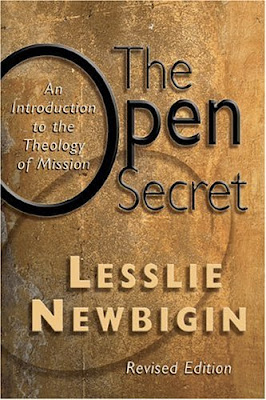Book Review: The Open Secret - Lesslie Newbigin
 Newbigin’s “introduction” wrestles with the vast and complex nature of the theology of mission, specifically in regards to the “missionary nature of the church” (p. 1). With the West having undergone, and still undergoing, such vast cultural and systemic shifts, he is understandably both engaging the shift through a trinitarian lens of how the church proper can engage the changing culture, but also how the church can engage in a holistic way. The dichotomy of justice verses conversion must change, he adds, and that the “first need” of these dichotomies “is for theological understanding” as well as a “restructuring of structures” (p. 11). He continues to assert this holistic perspective of mission by pointing out the implications of the confession of “Jesus as Lord.”
Newbigin’s “introduction” wrestles with the vast and complex nature of the theology of mission, specifically in regards to the “missionary nature of the church” (p. 1). With the West having undergone, and still undergoing, such vast cultural and systemic shifts, he is understandably both engaging the shift through a trinitarian lens of how the church proper can engage the changing culture, but also how the church can engage in a holistic way. The dichotomy of justice verses conversion must change, he adds, and that the “first need” of these dichotomies “is for theological understanding” as well as a “restructuring of structures” (p. 11). He continues to assert this holistic perspective of mission by pointing out the implications of the confession of “Jesus as Lord.” This confession, he adds,
“implies a commitment to make good that confession in relation to the whole life of the world – its philosophy, its culture, and it politics no less than the personal lives of its people. The Christian mission is thus to act out in the whole life of the whole world the confession that Jesus is Lord of all” (p. 17).
He then gives a framework for this Christian mission – a Trinitarian framework, no less. He looks through the lens of mission with three filters – “as proclaiming the kingdom of the Father, as sharing the life of the Son, and as bearing the witness of the Spirit” (p. 29).
The introduction really serves as an overview of the book’s seeming intent, so my review of this book led me to ask the following, more specific, questions about the Trinitarian nature of mission:Newbigin’s view of mission as faith in action is firmly rooted in the proclamation of the kingdom of the Father. “The announcement concerns the reign of God,” he states (p. 30). This faith is firmly rooted in the reign, or kingdom, of God. Interestingly enough, Newbigin points out that the “supreme deed by which the reign of God is both revealed and hidden, is the cross” (p. 35). He goes on to say that the proof for the cross as supreme act of kingdom victory, is the resurrection (p. 36). Newbigin asserts that “God is indeed active in history” (p. 39). But how is this activity manifest in regards to mission? He goes on to answer this important question when he says that God’s “action is hidden within what seems to be its opposite – suffering and tribulation for his people” (p. 39). It is by faith that we proclaim the reign of God, and it is by faith that we endure suffering for the sake of this reign, this kingdom. That is our mission.
What made the
Concluding this Trinitarian perspective of mission is the view of mission as hope in action. This is a specific reference to the work and person of the Holy Spirit. Newbigin is quick to point out that it is “by an action of the sovereign Spirit of God that the church is launched on its mission” (p. 58). This grounds the mission of the church, according to Newbigin, in the sovereign activity of the Holy Spirit. But what does he mean by “hope in action?” He means that “by obediently following where the Spirit leads, often in ways neither planned, known, nor understood, the church acts out the hope that it is given by the presence of the Spirit who is the living foretaste of the kingdom” (p. 65). This is probably Newbigin’s best definition of hope in action.
I have dealt specifically with Newbigin’s theological framework which is deeply embedded in the Trinitiarian perspective of mission as faith, love, and hope as a reflection of the Father, Son and Holy Spirit. In the ensuing chapters, Newbigin goes on to discuss the more practical problems and issues that arise out of this framework as the church does take hold of her missionary calling. He does this in part by dealing with the false separation of justice and preaching (p. 91), and by taking to task the church growth movement and its weaknesses (p. 121-124). As enlightening as these discussion are, they are out of the scope of this review, but are worth the read as practical handles for the implications of a Trinitarian perspective of mission.